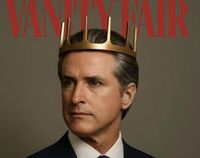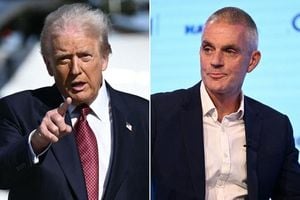In the waning days of August 2025, a media storm erupted over rumors that Vanity Fair was considering a cover feature on First Lady Melania Trump. What began as a speculative editorial decision quickly spiraled into a cultural flashpoint, drawing in political heavyweights, media personalities, and the ever-watchful eyes of the American public. The saga, which unfolded across social media and newsrooms alike, revealed much about the current state of American media, celebrity culture, and the deep divisions that still define the country’s political landscape.
The controversy kicked off when Mark Guiducci, newly installed as Vanity Fair’s global editorial director, floated the idea of featuring Melania Trump on the magazine’s cover. According to Daily Mail and corroborated by several outlets, Guiducci’s proposal was met almost instantly with internal revolt. One editor, quoted by the Daily Mail, didn’t mince words: “I will walk out of the motherf***ing door, and half my staff will follow me.” The sentiment was echoed throughout the editorial ranks, with another staffer declaring, “We’re not going to normalize this despot and his wife.” The threat of a mass walkout painted a vivid picture of the ideological fault lines within the publication.
As reported by RadarOnline.com and La Voce di New York, the uproar was not just about Melania Trump herself, but what her appearance would represent—a perceived capitulation to the Trump family’s influence, and a betrayal of the magazine’s values. Yet, some observers argued that the real issue was not political bias but a lack of editorial daring, with critics noting that Vanity Fair had lost its edge since the departure of legendary editors like Graydon Carter and Tina Brown. “The problem with Vanity Fair is not that it is too ‘woke’ but that it is too boring,” wrote Sarah Baxter, director of the Marie Colvin Center for International Reporting, lamenting the magazine’s decline in cultural relevance.
The debate over Melania’s potential cover was further complicated by her own complicated relationship with the media. While she was never featured on the U.S. edition of Vanity Fair, Melania did appear on the cover of Vanity Fair Mexico in February 2017, shortly after Donald Trump’s first presidential victory. Her ties to the fashion world run deep—her wedding dress, a Dior creation adorned with 1,500 pearls and rhinestones, was famously selected with the help of Vogue’s Anna Wintour and André Leon Talley. Yet, as Donald Trump’s political fortunes rose, Melania found herself increasingly ostracized by the very publications that once celebrated her. During Trump’s first term, Vanity Fair and Vogue reportedly banned her from their pages, while lavishing coverage on First Lady Jill Biden and Vice President Kamala Harris during Joe Biden’s presidency.
Against this backdrop, rumors of a Melania cover felt like a seismic shift—or perhaps, to some, a betrayal. The reaction wasn’t confined to the newsroom. As the story gained traction online, California Governor Gavin Newsom joined the fray, using social media to mock both Melania and the magazine. In a tongue-in-cheek post, Newsom shared a doctored image of himself as “The American King,” a playful riff on a fake Vanity Fair cover of Melania Trump wearing a crown with the caption “The American Queen.” Newsom’s post, complete with the tagline “Hair, gel, and the art of being so Handsome,” was a direct jab at both the First Lady and the Trump administration’s penchant for self-glorification. His press office even chimed in, joking, “AN HONOR! THANK YOU!!!” in the all-caps style favored by Donald Trump himself, as noted by La Voce di New York.
The fake Melania cover, which also bore the line “Fashion, power, and the art of saying nothing,” spread quickly across the internet. Fox News host Laura Ingraham initially took the bait, praising the image and declaring, “Let the meltdown begin. Love it,” before later clarifying, “Real or not real… hilarious to read the Left’s reaction.” The episode underscored the blurred lines between satire, misinformation, and genuine news in the digital age, as well as the eagerness of partisans on both sides to seize on any opportunity for mockery or outrage.
Despite the uproar, Melania Trump herself seemed unfazed. Multiple sources cited by RadarOnline.com and La Voce di New York claimed that she “laughed off” the idea of appearing on Vanity Fair’s cover, with one insider saying, “Her priorities as First Lady are far more important. These people don’t deserve her anyway.” Another source added, “She’s way above doing Vanity Fair. She’s been nothing but kind and works hard… She has her priorities straight.” Indeed, Melania has spent much of her time as First Lady out of the public eye, focusing on initiatives that often diverge from her husband’s platform. In her 2024 memoir, Melania, she revealed a willingness to break with Donald Trump on issues like abortion rights and the impact of social media on young people.
Recent events have only heightened the scrutiny surrounding the First Lady. Earlier in 2025, following a tragic shooting at a Catholic school in Minneapolis that left two children dead and 18 injured, Melania called for “pre-emptive intervention” to identify potential shooters. The statement was notable given the fraught national debate over gun control, as well as the fact that Donald Trump himself survived an assassination attempt by a disturbed 20-year-old in July 2024.
For Vanity Fair, the episode has exposed deep tensions within its ranks and raised questions about the magazine’s future direction. Once a tastemaker and cultural force, the publication now finds itself caught between competing demands: the expectations of legacy readers, the sensibilities of a younger, activist staff, and the realities of a polarized America. Some argue that featuring Melania Trump would have been a bold move, a chance to probe the enigmatic First Lady on her influence, her distance from her husband, and her views on issues like gun control and foreign policy. Others see it as an unacceptable normalization of a controversial administration.
In the end, the point may be moot. After years of snubs from the fashion media, Melania Trump reportedly declined the cover offer without hesitation. “She doesn’t need them anymore,” one observer remarked, paraphrasing the iconic line from Sunset Boulevard: “I am big. It’s the magazines that got small.”
This latest media skirmish, with its blend of satire, outrage, and celebrity intrigue, offers a snapshot of an America still deeply divided—not just over politics, but over the very question of who gets to define its culture.





